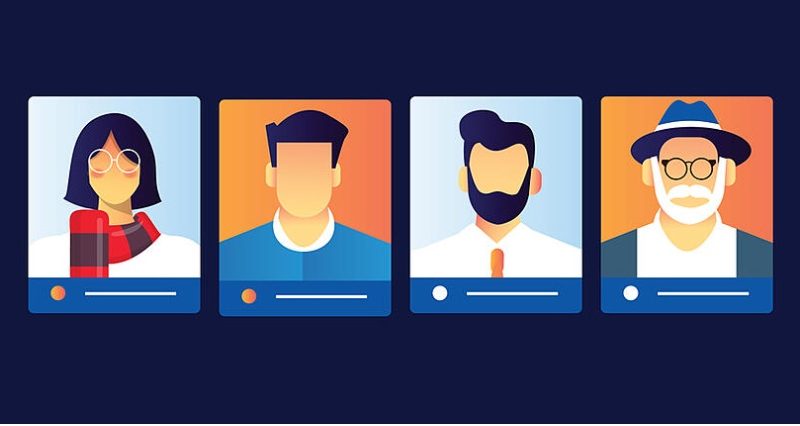A buyer persona is a semi-fictional depiction of your ideal customers. They assist you in focusing your time on solid leads, guiding product development to meet the needs of your target market, and coordinating all activities across your organization (from marketing to sales to service). As a result, it helps to attract high-value visitors, prospects, and customers to your business, who are more likely to stick around. Basically, knowing your buyer persona(s) inside-out is vital for content production, product development, sales follow-up, and pretty much anything else that has to do with customer acquisition and retention. And with this guide in place, you will be able to get a hang of creating a buyer persona in no time— examples included.
What is a Buyer Persona?
According to HubSpot, a buyer persona is a half-fictional replica of your ideal customer based on market research, actual customer data, plus a few (informed) assumptions. It assists you in comprehending and relating to the target audience for your products and services.
In other words, buyer personas are an essential component of any marketing plan (if not the most crucial).
You can design a marketing and sales strategy based on your target audience’s objectives, day-to-day issues, and ‘pain spots’ by forensically analyzing trends, behaviors, similarities, and patterns. And by generating prospect-focused marketing campaigns and content, you demonstrate to your target audience that you understand their business pains and concerns, encouraging them to interact with your company further.
Why is a Buyer Persona Important?
Buyer personas are crucial to any marketing strategy and are used throughout the entire Inbound process. You will lose your potential consumers’ trust and attention if you are unable to communicate with them in a meaningful and contextual manner. It’s difficult to regain someone’s confidence and interest once you’ve lost it.
You don’t have a second chance to make a good first impression!
And this is why buyer personas are so crucial.
Buyer personas enable you to focus on your prospects’ concerns and pain areas while also providing you with a complex and accurate marketing power to reach the right people at the right time with the right information.
Buyer personas, more than anything else, tell you what your company should be doing to assist potential clients. We wouldn’t know what content to develop, which materials to promote, how to direct our marketing efforts, or where to strengthen our presence if we didn’t have buyer personas. They are the story’s context, the framework in which our efforts are housed. They are the compass that directs our path and points us in the right way.
Remember, the goal of creating buyer personas is to figure out who you want to attract, who you want to enchant with your incredible content and insight, and who you want to finally join your firm.
Additionally, having clear buyer personas allows you to segment your audience and contacts, allowing you to provide forensically accurate, focused messaging. You want to be particular and detail-oriented in this day of information overload. The easier it is to break through the clutter of information online and communicate with your target audience, the more personalized and accurate your marketing and content will be.
What About Buyer Personas That Are “Negative”?
A negative — or “exclusionary” — persona is a representation of who you don’t want as a customer, whereas a buyer persona is a representation of who you want as a customer.
Professionals who are too advanced for your product or service, students who are just interested in your content for research/knowledge, or potential clients who are simply too expensive to acquire are examples of the negative buyer persona. This could be because of a low average sale price, their propensity to churn, or their unlikeliness to purchase again from your company.
How Can Buyer Personas Be Used in Marketing with Examples?
Creating personas allows you to generate content and messaging that appeals to your target audience at the most fundamental level. It also allows you to tailor or target your marketing to different segments of your audience.
Instead of sending the identical lead nurturing emails to everyone in your database, segment your database by buyer persona and personalize your messaging based on what you know about each persona.
Buyer personas also help you to plan out and generate highly targeted content when combined with the lifecycle stage (i.e. how far along someone is in your sales cycle).
If you additionally build negative personas, you’ll have the extra benefit of being able to separate the “bad apples” from the rest of your contacts, which can help you cut your cost-per-lead and cost-per-customer — and, as a result, see improved sales productivity.
How Are Buyer Personas Used?
The process of creating a buyer persona is in itself instructive.
To create a character, you must first ask yourself detailed questions about your potential customers, and this exercise will help you notice aspects you didn’t notice previously.
You can then compare your responses to those of your coworkers, revealing any differences in your viewpoints and encouraging dialogues to resolve them.
One of the first advantages of a buyer persona is that it aids in customer insight and cross-departmental coordination. This will ensure that everyone in your company, including marketing, sales, product development, and customer service, has the same vision of your ideal customer.
Read Also: MARKET RESEARCH: definition, Types, & Guide To Different Research Method
Your personas can then be used to direct the course of your work. Consider the following buyer persona examples:
- Buyer personas can be used in the formulation of product roadmaps — Personas will assist you in identifying and prioritizing changes to your offering based on the most pressing needs of your customers.
- Buyer personas can be used in marketing to create effective strategies — A buyer persona is crucial when developing content marketing strategies, for example. They assist in focusing keyword research efforts and serve as a guide when writing copy. They can also assist in determining and prioritizing promotional activities.
- Buyer personas also assist your sales team in establishing relationships with new clients — Your sales team will be a lot more productive if they understand what the prospect is going through and are prepared to solve their worries.
- Finally, personas can be used by customer service teams to better assist their clients — Your support crew will be able to exhibit greater empathy if they are trained on the problems your customers are trying to solve with your product and the frustration they experience when things don’t work out. When dealing with an irate consumer, a little compassion can go a long way.
Should Very Small Businesses Bother Building Buyer Personas?
Buyer personas are open for firms with a large number of employees, but if you’re a solopreneur or a very small business, you might be asking why you should bother. After all, you already know who your customers are, so wouldn’t this be a waste of time?
No, no, and no. It’s not going to happen. When you want anything, it’s often helpful to have a clear idea of what you’re chasing.
Consider the following scenario:
You’re a self-employed personal trainer. You have a website and a blog where you give fitness-related advice. You obviously want to attract customers who are looking to hire a personal trainer. A buyer persona will assist you in focusing your efforts.
Perhaps the majority of your consumers are young mothers in their thirties. If this is a market you’d like to keep serving, you can now tailor your website and blog material to specifically target this niche. This will make it easy for you to compose website copy and choose blog themes that will appeal to your target audience.
Types of Buyer Personas
“What are the different types of buyer personas?” you might wonder when you start working on your personas. It should be straightforward to adapt one for your company from there, right?
However, that isn’t exactly how it works; there isn’t a defined list of globally recognized buyer personas to choose from, and there isn’t a predetermined amount of personas you should create. This is because each company (no matter how many competitors it has) is unique, and as a result, its buyer personas should be as well.
As a result, identifying and building your various buyer personas can be a little difficult at times.
In general, businesses’ buyer personas may fall into the same or similar categories (e.g. a marketer, an HR rep, an IT manager, etc.). But, the number of personas your company needs and the kind of personas it has will be determined by who your target audience is and what you have to offer them.
Are you ready to create your buyer personas now?
Buyer Personas: How to Create Them With Examples
Your buyer persona should be founded on real-world data and strategic goals, not just someone you want to hang out with. Here’s how to create a fictional consumer who fits your real-world brand perfectly.
#1. Do Thorough Audience Research
It’s time to get down to business. Who are your current clients? What is the demographic of your social media audience? Who do your rivals want to target?
A good place to start is to gather audience information from your social media analytics (particularly Facebook Audience Insights), your customer database, and Google Analytics to focus on specifics like:
- Age
- Location
- Language
- Spending power and patterns
- Interests
- Challenges
- Stage of life
It’s also a good idea to know which social media platforms your target demographic uses. You can take a trip to our post on social media marketing to get a proper hang of doing this rightly.
#2. Identify Customer Goals and Pain Points
Depending on the products and services you sell, your audience’s aspirations may be personal or professional. So the question is; What drives your consumers’ behavior? What is their ultimate goal?
On the other hand, they have their own set of problems. What challenges or annoyances are you hoping to alleviate for your potential customers? What’s keeping them from achieving their goals? What obstacles do they have to overcome in order to achieve their objectives?
Your sales staff and customer service department are excellent resources for finding answers to these inquiries, but again social listening and sentiment analysis are also viable options.
Setting up search streams to track brand, product, and competitor mentions offers you a real-time view of what people are talking about you online. You can find out why they like your products or which aspects of the consumer experience aren’t working for them.
#3. Understand How You Can Help
It’s time to consider how you will be able to assist your consumers now that you have a better understanding of their goals and challenges. This entails looking beyond the characteristics and determining the underlying value of your product or service.
What your product is or does is referred to as a feature. The way your product or service makes your customer’s life easier or better is referred to as a benefit.
Consider your audience’s primary purchasing barriers and where they are in the sales process. Then ask yourself, “How can we assist?” In one straightforward sentence, express the answer.
#4. Create Your Buyer Personas
Gather all of your information and start pin-pointing commonalities. You’ll have the foundation for your distinct consumer personas once you’ve grouped those attributes together.
Give your buyer persona a name, a job title, a place to live, and other distinguishing features. You want your persona to come out as genuine.
Let’s imagine you’ve identified a key client category as 40-year-old, professionally successful city-dwelling women without children who enjoy superb restaurants. “High-Achiever Haley” might be your buyer persona. More detailed information about her could include the fact that;
- She is a 41-year-old woman.
- Three times a week, she attends a spin class.
- She lives in Toronto and runs her own public relations agency.
- A proud owner of a Tesla.
- She and her partner travel abroad twice a year and love to stay in boutique hotels.
- She belongs to a wine club.
Read Also: Benefits of Digital Marketing over Traditional Marketing
You get the idea: this isn’t only a list of qualities. This is a specific, thorough description of one potential customer. It allows you to think about your possible buyer as a person, rather than a collection of numbers. These characteristics may or may not apply to every customer in your target market, but they help to portray a prototype in a concrete way.
Aim for around the same amount of information you’d find on a dating site (but don’t forget to add any pain spots, which may or may not be acceptable on Bumble).
Be careful to describe both who each persona is now and who they want to be as you fill out your consumer personas. This helps you to consider how your products and services can assist customers in achieving their goals.
Examples of a Buyer Persona
In a variety of methods with examples below, brands can build and communicate a buyer persona with their teams. It could be a simple collection of bullet points or a multi-paragraph tale. A stock photo or graphic could be included. There’s no right or wrong way to format these reference documents; do what works best for your team in terms of understanding your customers (and target personas).
#1. Karla Is a Beauty-Conscious, Magazine-Loving Mother
Here’s an example from James Donovan, a UX designer. It develops a buyer persona for a fictional consumer named Karla Kruger, containing information on her work, age, and demographics, as well as her pain points and objectives. She’s 41 years old and expecting a child, and we know everything there is to know about her beauty routine and product preferences.
This example is unique in that it includes her media intake as well as her favorite businesses. In other words, you need to get really specific when it comes to bringing a consumer character to life.
We can also examine where “Karla” falls on the brand loyalty, social influence, and price sensitivity spectrums. If you need to know these kinds of data about your customer, look for them during your research and put them in your persona template!
#2, A Dedicated Suburban Home Cook
This buyer persona example from Survey Monkey brings a fictional data analyst to life. It reveals all about her schooling and where she lives, as well as her interests and passions – she enjoys cooking and traveling, places a high value on relationships, and is a brand loyalist.
What would your marketing approach or product offers be like if this were your company’s regular client? A well-defined buyer persona aids in the framing of every decision you make.
#3. A Young Professional Who Loves Dogs
We learn about Tommy Technology’s income and love life, as well as his work problems, in this buyer persona produced by digital marketing agency Single Grain. Incorporating some quotes (either repurposed from real customers or made up) might also help give this character a voice.
Tommy Technology’s buyer profile includes information like income, marital status, and future career goals.
Conclusion: Examine your Personas
Now that you have the aforementioned information (especially the buyer persona examples), you can create a textual or graphic framework (whatever helps you assimilate information quickly) that will allow you to understand exactly where your buyer persona’s pain spots are and how you can alleviate them while also providing answers to other issues.
You’ll be able to maintain your buyer personas more easily if you use a growth marketing platform. You’ll be able to ask all the required questions and receive the answers you need to move forward using the forms you make (you know, those neat little boxes on the right of the page or at the bottom inviting you to subscribe and submit details?). Once a customer registers their interest and subscribes, you can use the data you’ve gathered to create trend maps and identify common denominators among your website’s visitors.
Alternatively, you can phone up fascinating prospects with no intention of selling anything, simply to have a chat and figure out what they enjoy about your website, what they know about you, and what you can improve. Consider it a reflective questionnaire; the goal is to collect as much information as possible in order to assist this person. At this point, nothing should be sold to them.
Read Also: Growth Strategy: 5 Proven Frameworks for any Business with Examples
The analytics of your website is another factor to consider. They enable you to determine the nature of the inquiries that come into your site, as well as when they came, what they put in to get there, and how long they spent on a page. You’re undoubtedly asking yourself, “Why do I need this?” It’s a reasonable question. The answer is that data is crucial. The more information you can gather about your target audience and develop a pattern or uncover commonalities, the easier it will be to create and incorporate buyer personas.
Furthermore, having a shared knowledge of buyer personas and arrangements throughout the organization is also important, since your buyer personas form the foundation of your content development and content marketing strategy – which will attract interested parties, who will then convert into customers. Campaigns grow more effective as both marketing and sales have a better understanding of the individuals they are marketing and selling to, allowing you to create amazing content that promotes a specific business goal. Another good reason to work with your sales staff while establishing these personas is that it will increase their buy-in to the entire process.
When it comes to building personas, there is no such thing as too much information because the more information you have, the more thorough and accurate your personas will be. You can also use surveys to gather information and statistics that will help you create and develop your buyer personas.
Buyer Persona FAQs
What is a buyer persona examples?
Here’s one of the many examples from James Donovan, a UX designer on buyer persona. It develops a buyer persona for a fictional consumer named Karla Kruger, containing information on her work, age, and demographics, as well as her pain points and objectives. She’s 41 years old and expecting a child, and we know everything there is to know about her beauty routine and product preferences.
What is a buyer persona and why is it important?
A buyer persona is a half fictional replica of your ideal customer based on market research, actual customer data, plus a few (informed) assumptions. It assists you in comprehending and relating to the target audience for your products and services.
Buyer personas are crucial to any marketing strategy and are used throughout the entire Inbound process. You will lose your potential consumers’ trust and attention if you are unable to communicate with them in a meaningful and contextual manner. It’s difficult to regain someone’s confidence and interest once you’ve lost it.
What are buyer personas used for?
The importance of buyer personas in market segmentation cannot be over-emphasized. They enable you to divide your consumers into various categories. Knowing your clients’ various motives and purchasing behaviors will enable you to target different groups accordingly.










